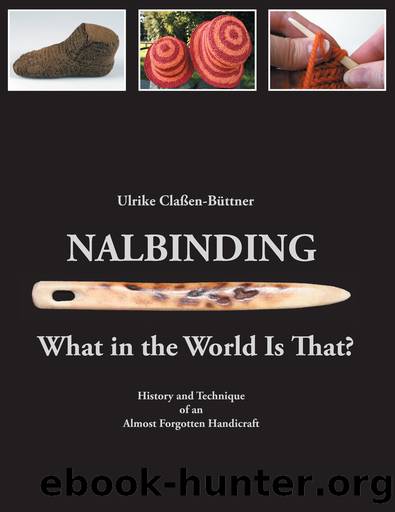Nalbinding--What in the World Is That? by Ulrike Claßen-Büttner

Author:Ulrike Claßen-Büttner
Language: eng
Format: epub
Publisher: Books on Demand
Published: 2015-03-15T00:00:00+00:00
Fig.48: Quick and easy! Large and small needles carved out of an ice-cream stick (ucb).
Which yarn is best?
Basically, any yarn can be used for nalbinding. The best beginner yarn is thick and made of genuine sheep wool that can be felted (not âsuperwashâ or other felt-free yarn). This is important, because the easiest way to add new pieces of yarn without having ugly knots in the fabric is to felt the old and new yarn together. To better see where individual loops are, beginners should work with light-colored yarn that is evenly spun and not fuzzy.
Experienced nalbinders could in principle use any thread-like structure for nalbinding. You can make sun hats from paper yarn or raffia bast, rugs from old cut-up T-shirts, necklaces and bracelets from thin wire or leather, and tote bags from strips of old plastic bags.
A frequently asked question is how thick the yarn should be. For beginners, a thick, single-ply yarn is recommended. The archaeological finds are, however, usually made from significantly thinner threads. In the York sock, for example, there are 36 nalbound rows per 10 cm (Walton 1989, p.342). In the Middle Ages nalbound gloves for the nobility and the clergy were even made from very fine silk yarns (see chapter on the Middle Ages).
If you work with a thin thread and use a stitch that has few loops, you may find that the fabric ends up very loose and net-like. If your thumb is too thick for the particular stitch, you can add an additional step when working: after a loop has been pushed behind the thumb, you can pull it tighter. Do this while the needle is still in the loop, so the needle can be used as a gauge instead of the thumb. Stitches with many loops turn out dense even on a big thumb.
When choosing the yarn, it is also important to consider how the finished textile will be used. Making socks with thick woolen yarn is quick, and the socks are really warm. But single-ply yarns are soft, so the socks quickly get holes. Wool can felt if you donât wash it carefully. If you want to felt your socks on purpose, it will increase their durability and make them even warmer, but they will shrink up to 30% and may become so hard that they are more suitable as shoes.
Depending on the stitch used and personal nalbinding style, you sometimes turn the needle with every stitch. Then the yarn might untwist or get more twisted and kink while working. You can avoid this by occasionally turning the needle in the other direction, or by using a yarn that was specially spun for your purpose. For the à sle stitch Briansdotter (2000, p.8) suggests, for instance, a Z-spun single or a Z-plied yarn. When using loosely spun yarn, Larry Schmitt advises that the length of the spun fibers be longer than the length of yarn you need per loop (Schmitt 2000, p.6) to avoid the yarn breaking.
Spinners can produce their own yarns of suitable thickness and strength for any project.
Download
This site does not store any files on its server. We only index and link to content provided by other sites. Please contact the content providers to delete copyright contents if any and email us, we'll remove relevant links or contents immediately.
Guns, Germs and Steel by Diamond Jared(2303)
Collapse: How Societies Choose to Fail or Succeed by Jared Diamond(1476)
The Emperor of All Maladies by Siddhartha Mukherjee(1392)
Transcendence by Gaia Vince(1111)
148424513X by Unknown(1021)
Seven Skeletons by Lydia Pyne(1017)
Sapiens - A brief history of humankind (Marathi) by Yuval Noah Harari(947)
Civilization One by Christopher Knight(945)
The Rational Optimist: How Prosperity Evolves by Matt Ridley(942)
Guns, Germs, and Steel: The Fates of Human Societies by Jared M. Diamond(905)
THE MASTER AND HIS EMISSARY by Iain McGilchrist(904)
Underworld The Mysterious Origins of Civilization by Graham Hancock(872)
Marco Polo by Laurence Bergreen(872)
At Home by Bill Bryson(865)
Atrocitology by Matthew White(859)
How the Irish Saved Civilization by Thomas Cahill(855)
The World Until Yesterday: What Can We Learn From Traditional Societies? by Jared Diamond(837)
Ancient Iraq by Georges Roux(826)
Guns, Germs and Steel: The Fates of Human Societies by Jared Diamond(822)
